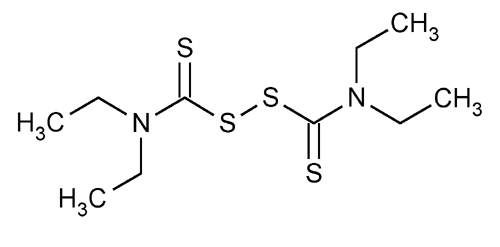Disulfiram
Thioperoxydicarbonic diamide [(H2N)C(S)]2S2, tetraethyl-.
Bis(diethylthiocarbamoyl) disulfide
» Disulfiram contains not less than 98.0 percent and not more than 102.0 percent of C10H20N2S4.
Packaging and storage—
Preserve in tight, light-resistant containers.
Identification—
B:
The retention time of the major peak in the chromatogram of the Assay preparation corresponds to that in the chromatogram of the Standard preparation, as obtained in the Assay.
Residue on ignition  281
281 :
not more than 0.1%.
:
not more than 0.1%.
Selenium  291
291 :
0.003%.
:
0.003%.
Assay—
Buffer solution A—
Dissolve 68 g of monobasic potassium phosphate in 1000 mL of water.
Buffer solution B—
Dilute 100 mL of Buffer solution A with water to 1000 mL, and adjust with 45% potassium hydroxide solution to a pH of 7.0.
Mobile phase—
Prepare a filtered and degassed mixture of methanol and Buffer solution B (70:30). Make adjustments if necessary (see System Suitability under Chromatography  621
621 ).
).
Standard preparation—
Dissolve an accurately weighed quantity of USP Disulfiram RS in alcohol with sonication and swirling if necessary to obtain a solution having a known concentration of about 1 mg per mL. [note—Discard this solution after 5 days.] Quantitatively dilute this solution with Mobile phase to obtain the Standard preparation having a known concentration of about 0.02 mg of USP Disulfiram RS per mL. [note—Prepare the Standard preparation fresh daily.]
Assay preparation—
Transfer about 50 mg of Disulfiram, accurately weighed, to a 50-mL volumetric flask, add about 40 mL of alcohol, sonicate for 5 minutes to completely dissolve, cool, dilute with alcohol to volume, and mix. [note—Discard this solution after 5 days.] Quantitatively dilute this solution with Mobile phase to obtain the Assay preparation having a concentration of about 0.02 mg per mL. [note—Prepare the Assay preparation fresh daily.]
Chromatographic system
(see Chromatography  621
621 )—The liquid chromatograph is equipped with a 250-nm detector and a 4-mm × 15-cm column that contains 5-µm packing L1. The flow rate is about 1 mL per minute. Chromatograph the Standard preparation, and record the peak responses as directed under Procedure: the column efficiency determined from the analyte peak is not less than 1800 plates; the tailing factor, T, for the analyte peak is not more than 2; and the relative standard deviation for replicate injections is not more than 2.0%.
)—The liquid chromatograph is equipped with a 250-nm detector and a 4-mm × 15-cm column that contains 5-µm packing L1. The flow rate is about 1 mL per minute. Chromatograph the Standard preparation, and record the peak responses as directed under Procedure: the column efficiency determined from the analyte peak is not less than 1800 plates; the tailing factor, T, for the analyte peak is not more than 2; and the relative standard deviation for replicate injections is not more than 2.0%.
Procedure—
Separately inject equal volumes (about 20 µL) of the Standard preparation and the Assay preparation into the chromatograph, record the chromatograms, and measure the responses for the major peaks. Calculate the quantity, in mg, of C10H20N2S4 in the portion of Disulfiram taken by the formula:
2.5C(rU / rS)
in which C is the concentration, in µg per mL, of USP Disulfiram RS in the Standard preparation; and rU and rS are the peak responses obtained from the Assay preparation and the Standard preparation, respectively.
Auxiliary Information—
Please check for your question in the FAQs before contacting USP.
Chromatographic Column—
| Topic/Question | Contact | Expert Committee |
| Monograph | Ravi Ravichandran, Ph.D.
Senior Scientist 1-301-816-8330 |
(MDPP05) Monograph Development-Psychiatrics and Psychoactives |
| Reference Standards | Lili Wang, Technical Services Scientist 1-301-816-8129 RSTech@usp.org |
USP32–NF27 Page 2187
Chromatographic columns text is not derived from, and not part of, USP 32 or NF 27.
